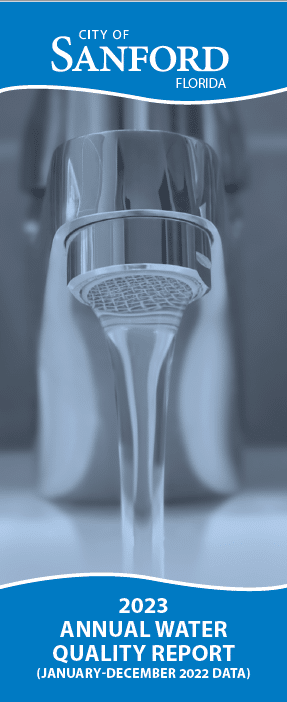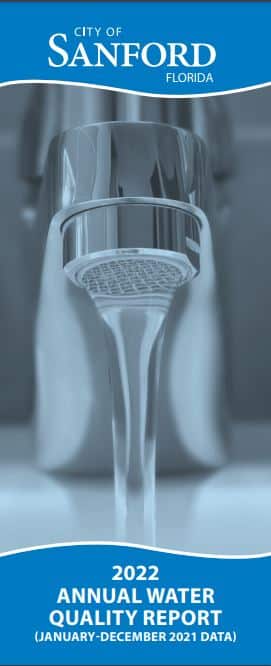Providing Top Quality Water to Your Tap
The City’s fundamental goal is to provide it’s citizens with a safe and dependable supply of drinking water. We are committed to ensuring the quality of your water and strive to continually improve the water treatment process
and protect our water resources.
Here’s what’s important to know-
Sanford's drinking water is safe to drink, based on state and federal guidelines.
The safety and security of our customers is our top priority, and the City of Sanford (City) is committed to providing safe drinking water to our customers. Recent media coverage has highlighted an ongoing issue regarding a contaminant in water samples – the same issue we have previously informed the public about. We remain committed to transparency – keeping our public fully informed.
Water Quality and Information About 1,4-Dioxane
We understand that residents may have concerns. Here are answers to common questions you may have.
What is the current situation regarding the City’s water quality?
The City is aware of the presence of contaminants (1,4-dioxane) that were likely discharged from a decommissioned industrial site (former Siemens site) in Lake Mary. The current level of contamination is low, and we are actively working to protect our water supply.
What is 1,4-dioxane?
1,4-dioxane is a synthetic industrial chemical used as a solvent stabilizer and is found at many sites contaminated with certain chlorinated solvents. 1,4-dioxane dissolves easily in water and has been found in groundwater throughout the United States. Its use at this facility has been discontinued. 1,4-dioxane was used and discharged at the former Siemens site in Lake Mary.
What is the City doing to ensure that drinking water remains safe?
The City regularly tests our water and adheres to strict state and federal regulations, including the Federal Safe Drinking Water Act. We have taken steps to diversify water sources to ensure that trace contaminant levels remain below safe water standards.
Is our water safe to drink?
Yes. The City’s water is in full compliance with all federal and state drinking water regulations, and is safe to drink. In 2017, the Florida Department of Health concluded that as long as levels of 1,4-dioxane levels in our water remain below 0.35 parts per billion (micrograms per liter), it is not likely to cause illness and continues to meet the FDOH’s health advisory level.
What are the current levels of 1,4-dioxane?
On June 2024, water quality samples for 1,4 dioxane were taken at the water treatment plants (WTPs) point of entry (POE) into the water distribution system (i.e., when the water exits the water treatment plant). Results showed that the levels of 1,4-dioxane in the City’s drinking water were 0.18 parts per billion (or micrograms per liter) at Water Plant No. 1 POE and < 0.12 parts per billion (or micrograms per liter) and Water Plant No. 2 POE. The City’s 1,4-dioxane levels at the POE are much lower than the threshold set by the Florida Department of Health (FDOH) of 0.35 parts per billion (or micrograms per liter).
What are regulators doing?
The Florida Department of Environmental Protection has the power and duty to regulate all discharges of pollutants, including discharges of 1,4- dioxane into the Floridan aquifer (a major source of water supply in the state of Florida) and to impose strict liability on those who make such discharges. We continue to work closely with local, state, and federal partners to address these challenges.
What is the City doing to continue to safeguard our water supply?
As part of the Bipartisan Infrastructure Act, the City of Sanford has applied for and been designated to receive $60 million in federal funds to build a new water treatment facility. The City is also seeking additional funds from related sources. This new facility will supplement our existing treatment capabilities and aid in our ability to monitor and manage contaminants that can potentially enter the water supply, including PFAS, 1,4-dioxane, and other pollutants.
What is being done to hold accountable those responsible for the contamination?
This contamination is indisputably due to the negligence of others, and the City has spent considerable resources to ensure that our drinking water remains within acceptable levels. Since 2013, City leaders have been at the forefront of working to hold those at fault accountable – and to ensure that they cover the cost of mitigation and cleanup efforts. We will continue to work with state and federal partners to make sure those liable are held responsible to the fullest extent of the law.
1,4-Dioxane is a synthetic industrial chemical used as a solvent stabilizer and is found at many sites contaminated with certain chlorinated solvents. 1,4-dioxane dissolves easily in water and has been found in groundwater throughout the United States. Its use has been discontinued. 1,4-Dioxane was used and discharged at the former Siemens site in Lake Mary.
The Environmental Protection Agency (EPA) periodically requires all water providers to sample a new list of contaminants that historically have not been regulated. The results of these tests are used by the EPA to consider regulations for the future. Like many utility providers in the area, the City of Sanford detected 1,4-dioxane in our groundwater when the EPA first directed utilities to sample for 1,4-dioxane. You may have seen the results of this Unregulated Contaminant Monitoring Rule testing, including 1,4-dioxane, in the City’s annual water quality report in 2016. While 1,4-dioxane remains unregulated, the Florida Department of Health established a health advisory limit maximum of 0.35 ug/L (micrograms per liter). To help visualize one ug/L, an equivalent measurement is 1 part per billion, similar to one drop of ink in a large tanker truck, or 1 second in 32 years.
Since becoming aware of the health advisory limit for 1,4-dioxane in 2016, the City has added this chemical to the scheduled sampling for our wells and treated drinking water. We also immediately reduced the use of groundwater wells that are most affected by this chemical. With these actions, we have maintained drinking water quality from 2016 to today with levels of 1,4-dioxane below the health advisory limit, averaging less than 0.20 ug/L (micrograms per liter). In 2016 the Florida Department of Environmental Protection (FDEP) advised the City of Sanford that it would find the source of the contamination. The City has been working with FDEP since then to determine the source. The City is encouraging the FDEP to expand its efforts and identify the source and responsible party to safeguard our water supply and minimize the impact to the City’s ratepayers.
Understandably this is the most common and important question asked of any water supplier, and the answer is YES! The City of Sanford has great water quality through the efforts of our water plant operators and engineers who sample the water regularly for all manner of natural and man-made components. While no drinking water (bottled or tap) is 100% pure, City of Sanford customers receive an annual water quality report that shows all regulated contaminants have been tested and are below drinking water standards set by the EPA and FDEP.




